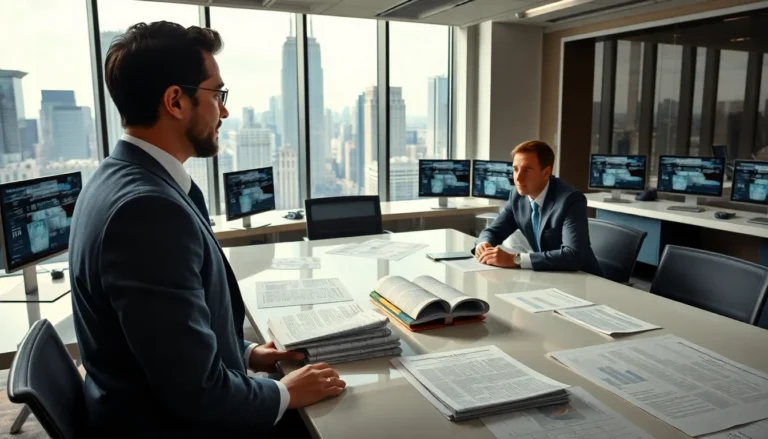Table of Contents
ToggleUrban design isn’t just about placing benches and trees in a park; it’s the secret sauce that makes cities thrive. Imagine walking through a vibrant neighborhood where every corner feels alive and inviting. That’s the magic of thoughtful urban design. It’s the art and science of creating spaces that not only look good but also work seamlessly for the people who live there.
Overview of Urban Design Concepts
Urban design encompasses a variety of principles and elements that shape the built environment. It involves the thoughtful arrangement of public spaces, the integration of transportation options, and the provision of amenities. These factors significantly impact community interaction, mobility, and accessibility.
Key concepts include mixed-use development, which combines residential, commercial, and recreational spaces to promote vibrant neighborhoods. Creating walkable areas enhances pedestrian experiences, reducing reliance on vehicles. Sustainable design principles ensure that urban areas support environmental health through green infrastructure, efficient land use, and renewable energy sources.
The concept of placemaking encourages participatory design, involving community members in decision-making to foster ownership and investment in local spaces. This engagement helps in identifying specific needs and preferences, leading to designs that resonate with the community.
In addition, context-sensitive design prioritizes the unique characteristics and culture of each area. By considering historical, cultural, and ecological factors, urban designers create environments that reflect the identity of their communities.
Furthermore, the use of technology in urban design has emerged, with smart city initiatives utilizing data to improve infrastructure and services. This integration fosters efficiency and enhances the quality of urban life.
Ultimately, urban design serves as a critical framework for shaping sustainable, responsive, and thriving cities. By addressing community needs and aspirations, urban design plays a vital role in creating harmonious living environments.
Key Principles of Urban Design
Key principles of urban design focus on creating functional and inviting spaces. These principles shape how communities interact with their environment, enhancing livability and sustainability.
Scale and Density
Scale and density significantly influence urban environments. High-density development promotes efficient land use, supporting more residents within walkable distances. It enables access to amenities and services, reducing dependency on cars. Compact designs foster vibrant neighborhoods by encouraging mixed-use spaces. Alternatives to sprawling developments include infill projects that revitalize underused areas. Designers also consider building heights and public spaces to maintain a human scale, enhancing the overall experience.
Connectivity and Accessibility
Connectivity and accessibility are vital in modern urban designs. Well-connected streets facilitate movement across neighborhoods, making it easier to navigate. Public transportation options should integrate seamlessly with pedestrian pathways, promoting public transit use. Accessible designs ensure that facilities and services meet the needs of all community members, including those with disabilities. For example, incorporating bike lanes promotes alternative transport methods, reducing traffic congestion. Urban design that prioritizes these elements encourages more active lifestyles and fosters community engagement.
Types of Urban Design Concepts
Urban design encompasses various concepts that enhance the livability and functionality of urban areas. Key types include walkable cities and green design.
Walkable Cities
Walkable cities prioritize pedestrian movement and access. Streets include amenities within walking distance, reducing reliance on cars. Residents enjoy healthier lifestyles through increased physical activity. Mixed-use developments create vibrant neighborhoods, fostering community interactions. Public spaces encourage socialization and local events. Effective walkability requires well-designed infrastructure, including sidewalks, bike lanes, and crosswalks. Improvements in accessibility enhance mobility for everyone, including those with disabilities. Research shows that walkable neighborhoods boost local economies and improve residents’ quality of life.
Green Design
Green design emphasizes sustainability in urban planning. Incorporating green infrastructure, like parks and green roofs, promotes biodiversity. Effective use of renewable energy, such as solar panels, reduces the carbon footprint of buildings. Urban landscapes include native plants to enhance ecological resilience. Implementing stormwater management techniques helps mitigate flooding risks. Sustainable materials in construction ensure minimal environmental impact. Community gardens contribute to local food production, fostering healthy eating habits. Eco-friendly practices directly support the broader goals of sustainable urbanism.
Observations from Successful Urban Design Projects
Successful urban design practices showcase innovative approaches to enhancing community livability and sustainability. They highlight significant lessons from various cities around the world.
Case Study: Barcelona
Barcelona demonstrates the benefits of integrating mixed-use development within urban environments. The Superblocks initiative reclaims streets for pedestrian use, prioritizing walkability and reducing vehicle emissions. This design fosters social interaction, encouraging local businesses and vibrant community spaces. Significant investments in green spaces enhance residents’ quality of life while supporting biodiversity. Pedestrian-friendly streetscapes feature amenities such as cafes and parks, reinforcing a sense of place and local identity.
Case Study: Copenhagen
Copenhagen exemplifies how cycling infrastructure can transform urban mobility. The city prioritizes bicycle lanes, promoting cycling as a primary mode of transport. Extensive investments in public transportation complement this strategy, reducing carbon footprints while enhancing accessibility. Public spaces like urban parks allow for recreation and socializing, contributing to community well-being. Furthermore, innovative green rooftops and sustainable building practices showcase the city’s commitment to environmental resilience and climate adaptation.
Challenges in Implementing Urban Design Concepts
Implementing urban design concepts presents various challenges that hinder effective development. Funding limitations often restrict innovative projects, making it difficult to realize ambitious plans. Community resistance frequently arises when proposals do not align with the unique needs or desires of residents. Lack of collaboration among stakeholders can lead to inadequate representation of diverse perspectives in the planning process.
Furthermore, regulatory constraints impact the implementation of sustainable practices. Zoning laws might restrict mixed-use developments and restrict the integration of green spaces. Inadequate infrastructure also poses significant hurdles, especially in areas lacking facilities to support walkable or cyclist-friendly environments. Limited access to technology further complicates efforts to create smart city initiatives.
Addressing the challenges of climate change requires a shift in traditional urban design thinking. Urban heat islands and flooding demand innovative solutions, yet often the urgency for transformation conflicts with established practices. Limited access to resources for renewable energy projects complicates the transition toward sustainability.
Public engagement plays a critical role in overcoming resistance and fostering support for urban design initiatives. Engaging the community effectively promotes ownership and investment in shared spaces. Resilience remains important as cities adapt to shifting demographics and changing climate conditions.
Ultimately, successful urban design hinges on robust and transparent communication among all parties. The complexity of implementation reflects the diverse needs of modern urban environments. By recognizing and addressing each challenge, professionals can create vibrant, inclusive, and sustainable spaces that enhance community living.
Urban design plays a pivotal role in shaping livable and sustainable communities. By integrating principles like mixed-use development and walkability, cities can create vibrant spaces that foster social interaction and promote healthier lifestyles. The emphasis on sustainability through green design and smart city initiatives reflects a commitment to environmental resilience.
Successful urban design requires collaboration and public engagement to navigate challenges and secure support from stakeholders. As cities continue to evolve, the focus on innovative solutions will be essential. By prioritizing community needs and embracing diverse design concepts, urban planners can transform spaces into thriving environments that enhance the quality of life for all residents.







